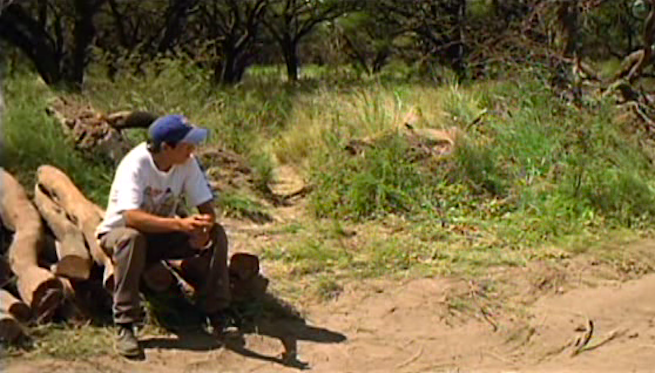Reframing Humans, Animals and Land in Contemporary Brazilian and Argentinian Cinema, Essay 2: Rural Time in the Early Films of Lisandro Alonso
May 11, 2019
Dana Khromov
The following post is an essay by Ashley Brock, Assistant Professor of Romance Languages at the University of Pennsylvania. It is the second of the 5-part series "Reframing Humans, Animals and Land in Contemporary Brazilian and Argentinian Cinema." In her essay, Ashley explores how Lisandro Alonso’s films engage duration and self-referentiality to interrogate questions of temporality and meaning in rural and urban spaces.
Rural Time in the Early Films of Lisandro Alonso
The early films that propelled Argentinian filmmaker Lisandro Alonso to international-film-festival fame are renowned for their long takes and rural settings. It would be easy to conclude that the slowness of these films, which might be described as tedious or contemplative, depending on your perspective, attributes to rural life a fundamentally different temporality. Alonso would not be the first to do so, as a long literary tradition has, whether longingly or critically, turned to pastoral settings to imagine an outside to modern history. Though Alonso, a native of Buenos Aires, is not immune to idealizing the countryside as a respite from the pace and alienation of urban life, I believe that in these films he is up to something more complex than rehashing either a nostalgic pastoral fantasy or a condemnatory portrait of backwoods stagnation. In other words, his protracted shots of peasants performing banal actions and of natural landscapes devoid of human figures do more than posit non-urban landscapes as places where nothing happens, where nothing changes. I see Alonso as capitalizing on cinematic technology and its unique capacity to make us experience duration in order to interrogate our temporal relationship to spaces we might think of as traditional, backwards, or left behind by modernity.


This becomes most apparent when we consider Alonso’s first three films, La libertad (2001), Los muertos (2004), and Fantasma (2006) as a trilogy. Though many critics bracket Fantasma, which enjoyed only a limited release and remains an outlier in Alonso’s corpus as the only feature-length film with an urban setting, I see it as the capstone of a project that includes the two preceding films. Fantasma is set in Teatro San Martín in Buenos Aires and features Argentino Vargas and Misael Saavedra, the non-professional actors who star in Los muertos and La libertad respectively, wandering around the nearly empty theater before, during, and after a screening of Los muertos. The reappearance of Saavedra and Vargas in Fantasma links the three together as a single filmic world, but unlike in the earlier films, the landscape featured is not the pampas or the forest, but the seemingly vast and labyrinthine modernist cinematheque. The campesino subjects who seemed so at home performing various forms of labor in their respective natural settings appear disoriented and at a loss for what to do with their bodies in this foreign space. Meanwhile, the local color in this world includes the theater workers—the ticket-taker, the usher, the security guard—who are shown not only performing their workplace duties but also absorbed in mundane tasks like eating and reading the newspaper. In this way, Alonso acknowledges the suitability of any life, including the urban lives of those in the film industry, as objects of pseudo-ethnographic fascination. Bringing Saavedra and Vargas into this urban, modern landscape also underscores the contemporaneity of their lives. They do not exist only in a distant time and place but also in our own.
Considering the three films together demands that we read the self-reflexivity of Fantasma into the earlier films as well. They are not simply portraits of peasant life but reflections on the predicament of experiencing the temporality of landscapes with which we are unfamiliar. If the temporal protraction of banal scenes thwarts expectations of the exotic and spectacular, it also provides an opportunity for the viewer to synch her experience to the rhythms of inhabiting this landscape. Can we, given enough time, experience Saavedra’s or Vargas’s rural world not as exotic or tedious, but as he experiences it: familiar, legible, pregnant with meaning? Can he, in turn, experience Teatro San Martín not as hostile and empty but as saturated with the significance it holds for Alonso and urban cinephiles? I believe in both cases the answer is no, not entirely. But in the exploration of these questions lies an ethical exercise that teaches us about our own capacity to attend to another perspective, to synch ourselves to another temporality, and to recognize the limits of our ability to find meaning in unfamiliar landscapes. The central question driving these films is thus not simply what does it feel like to dwell in a specific landscape, to be a native to it, but rather, how do we become aware of the possibility that others experience time and space differently than we do?
The full series here:
